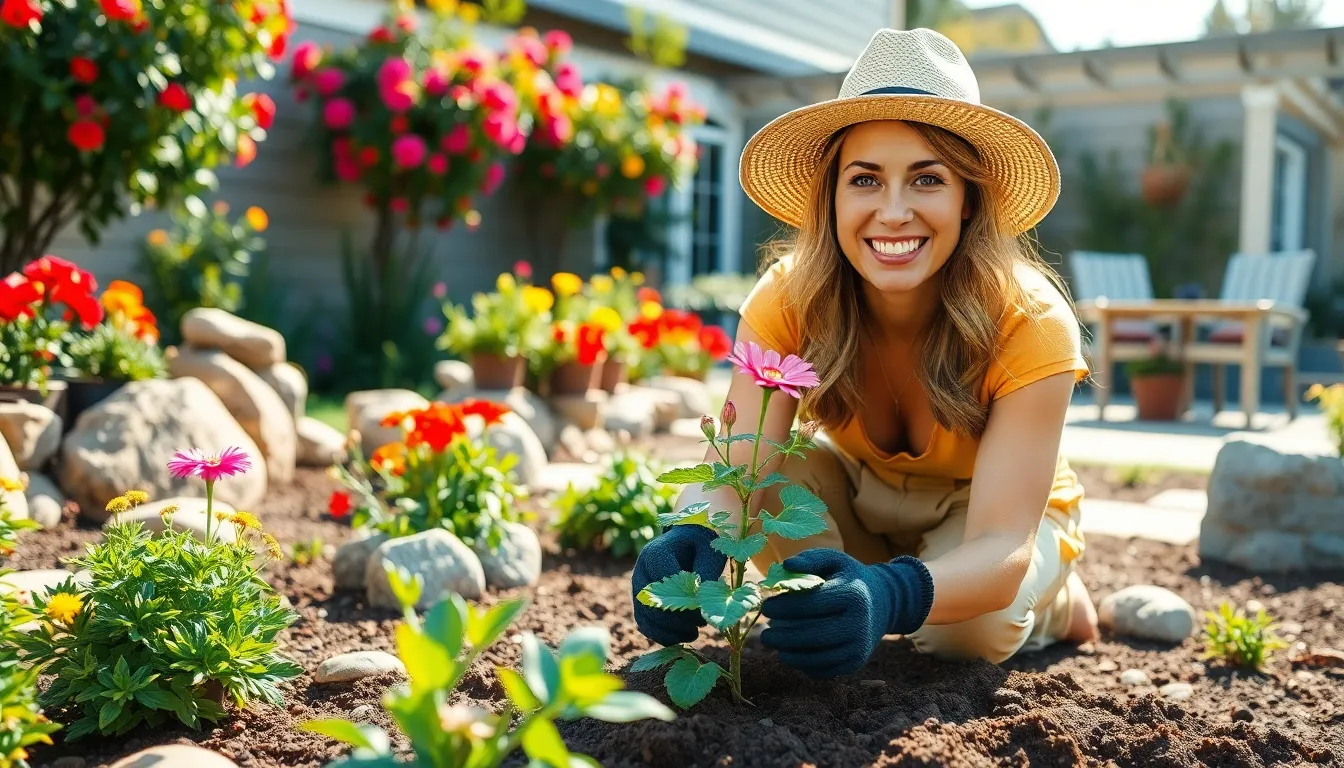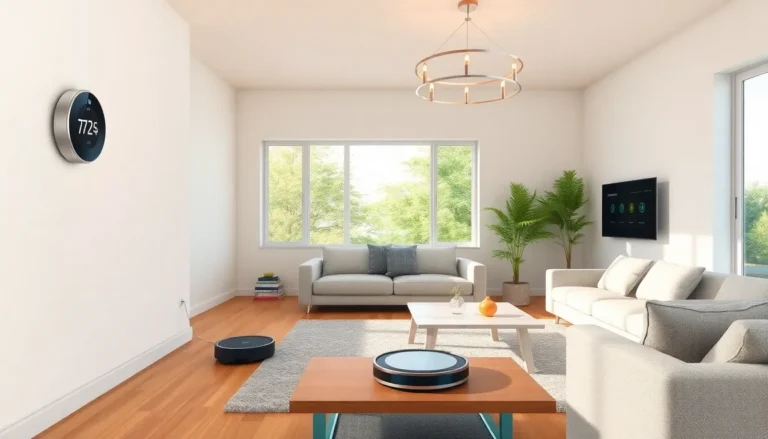Table of Contents
ToggleTransforming a garden over the weekend can be a rewarding experience that breathes new life into any outdoor space. With just a few simple changes, anyone can create a vibrant oasis that reflects their personal style. Whether it’s a small balcony or a sprawling backyard, a weekend garden makeover offers an opportunity to enhance curb appeal and enjoy nature right at home.
Weekend Garden Makeover Overview
Weekend garden makeovers focus on transforming outdoor spaces quickly and effectively. These projects often require minimal planning and can yield substantial visual impact. Simple changes, like rearranging furniture or introducing new plants, create an inviting atmosphere.
Individuals can enhance their garden’s aesthetics by incorporating a variety of elements. Colorful flowers, decorative stones, or unique garden sculptures can elevate any space. Additionally, container gardening allows for flexibility, making it easy to tailor gardens to personal preferences and seasonal changes.
Enhancing curb appeal is another significant benefit. Improving landscaping makes the property more attractive to visitors and potential buyers. Effective design choices create a welcoming environment that reflects the homeowner’s style while fostering enjoyment of natural surroundings.
Weekend makeovers also promote outdoor activities. A well-designed garden invites relaxation and social gatherings. Families can bond in an upgraded space, enjoying outdoor dining or gardening together. This transformation not only boosts aesthetics but also enhances the overall experience of home life.
Planning Your Makeover

Planning a garden makeover involves setting clear goals and establishing a budget. These steps help streamline the transformation process, ensuring effective results over the weekend.
Setting Goals
Setting goals clarifies the desired outcomes of the makeover. Garden enthusiasts should consider the following:
- Functionality: Identify how the garden will be used. Will it serve as a relaxation area, an entertainment space, or a vegetable garden?
- Aesthetic Preference: Define the desired style, such as modern, traditional, or rustic. This helps in selecting plants and decor elements.
- Timeline: Determine the project’s scope to fit into a weekend schedule, prioritizing tasks that yield maximum impact.
- Maintenance Level: Decide on a maintenance plan that aligns with lifestyle preferences. Low-maintenance gardens often require less ongoing effort while still looking appealing.
Budgeting for Your Project
Budgeting ensures the makeover aligns with financial resources. Consider these budget components:
- Materials: Estimate costs for plants, soil, mulch, and decorative elements. Pricing often varies based on quality and type.
- Tools and Equipment: Factor in any necessary tools, such as soil aerators or garden hoses. Renting equipment may also be a cost-effective option.
- Labor: Assess whether professional help is required for more complex tasks like landscaping. DIY efforts can save money while providing a personal touch.
- Contingency Fund: Allocate a small portion of the budget for unexpected expenses, typically around 10%. This flexibility aids in managing unforeseen challenges during the project.
Establishing clear goals and budgeting effectively facilitates a successful weekend garden makeover, ensuring a beautiful outdoor transformation.
Choosing the Right Plants
Choosing the right plants is crucial for a successful weekend garden makeover. Plant selections should align with the garden’s aesthetic, functionality, and maintenance requirements.
Seasonal Considerations
Selecting plants based on the seasons enhances the garden’s beauty throughout the year. For spring, consider tulips, daffodils, and pansies for early blooms. Summer offerings include sunflowers, zinnias, and coneflowers, which thrive in warmer temperatures. Autumn allows for the addition of asters, chrysanthemums, and ornamental grasses, providing vibrant fall colors. In winter, evergreens and holly maintain greenery and structure. Understanding local climate conditions helps in making appropriate choices, ensuring plants flourish in their designated environment.
Low-Maintenance Options
Low-maintenance plants simplify garden upkeep, allowing homeowners to enjoy their space with minimal effort. Consider native perennials, such as black-eyed Susans or daylilies, which are adapted to local conditions and require less watering. Succulents, like sedum and echeveria, thrive in dry areas and require infrequent watering. Ornamental grasses, such as fountain grass or blue fescue, add texture without excessive maintenance. Selecting these options creates a beautiful garden that conserves time and resources, allowing for more enjoyment of the outdoor space.
Design Ideas for Your Garden
Transforming a garden over the weekend requires creative planning. Effective design ideas enhance both functionality and visual appeal.
Layout and Structure
Creating a thoughtful layout maximizes garden space. Homeowners can consider various structural elements such as:
- Pathways: Use stones, gravel, or mulch to define walkways. Clearly marked paths guide visitors through garden areas.
- Zones: Divide the garden into distinct areas for relaxation, dining, or gardening. Each zone should serve a unique purpose, making the space more functional.
- Vertical Elements: Incorporate trellises or arches to add height. Vertical gardening efficiently uses space and showcases plants effectively.
- Seating Areas: Integrate durable furniture to create inviting spots. Benches or chairs encourage relaxation and enjoyment of the surroundings.
Arranging these components thoughtfully enhances the overall aesthetics and user experience while reflecting personal style.
Color Schemes and Themes
Choosing a cohesive color scheme can unify diverse garden elements. Consider these approaches for effective color treatments:
- Complementary Colors: Pair contrasting colors like purple and yellow or red and green. This approach creates visual interest and draws attention to specific areas.
- Monochromatic Schemes: Utilize various shades of one color for a subtle and serene look. Plant species in similar hues promote a calming atmosphere.
- Seasonal Themes: Select plants that highlight seasonal changes. Seasonal displays, like spring tulips or autumn chrysanthemums, offer dynamic beauty throughout the year.
- Natural Elements: Incorporate materials that mimic colors found in nature. Earthy tones and textures enhance the garden’s organic feel.
Applying these color techniques can create a cohesive and inviting outdoor space, showcasing each homeowner’s unique vision while blending harmoniously with its surroundings.
Execution of Your Makeover
Executing a weekend garden makeover involves careful selection of tools and materials, alongside a systematic process for implementation. By following these steps, homeowners can achieve efficient and effective transformations.
Essential Tools and Materials
Gathering the right tools and materials simplifies the makeover process. Essential items include:
- Shovels: Use for digging and moving soil or plants.
- Rakes: Ideal for leveling soil and removing debris.
- Pruners: Necessary for trimming and shaping plants.
- Gloves: Protect hands from thorns and dirt.
- Watering Can or Hose: Ensures proper irrigation of new plants.
- Soil and Compost: Improve soil quality and support plant growth.
- Mulch: Helps retain moisture and suppress weeds.
- Decorative Elements: Include stones, garden sculptures, or lighting for aesthetics.
Acquiring these items beforehand enhances preparedness and efficiency on the makeover day.
Step-by-Step Process
Executing the makeover follows a clear step-by-step process:
- Assess the Space: Evaluate the garden’s current state and identify areas for improvement.
- Set Goals: Define specific objectives such as enhancing aesthetics or functionality.
- Sketch a Plan: Create a visual layout, incorporating desired plants, structures, and focal points.
- Prepare the Area: Clear clutter, remove weeds, and level the ground as needed.
- Plant Selection: Choose plants that fit the design plan, considering color, height, and maintenance requirements.
- Install Structures: Place garden furniture, pathways, or trellises according to the layout.
- Planting: Follow proper spacing and planting depth for selected plants, ensuring each gets adequate sunlight and water.
- Finishing Touches: Add mulch, decorative elements, and ensure all areas are visually pleasing.
- Maintenance Planning: Develop a simple care routine for watering, pruning, and fertilizing to keep the garden vibrant.
Following these steps streamlines the execution of a weekend garden makeover, yielding a beautiful, personalized outdoor space.
A weekend garden makeover can truly transform any outdoor space into a personal sanctuary. With thoughtful planning and creative design, homeowners can create an inviting atmosphere that reflects their style and enhances their property’s appeal. Simple changes often yield impressive results, making it easier to enjoy nature right at home.
By focusing on the right plants and design elements, anyone can cultivate a flourishing garden that thrives throughout the seasons. The satisfaction of completing a makeover in just a weekend not only boosts curb appeal but also enriches family life. Embracing the beauty of a well-designed garden allows for relaxation and memorable moments outdoors.





